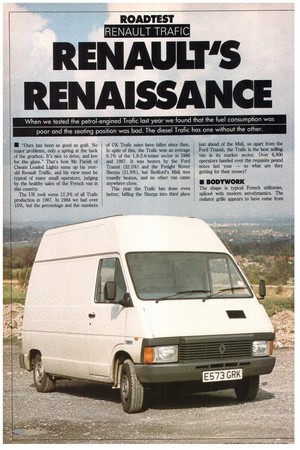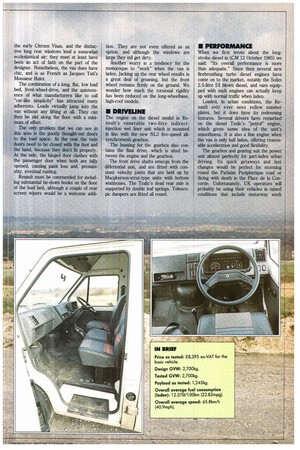RENAULT'S RENAISSANCE
Page 92

Page 93

If you've noticed an error in this article please click here to report it so we can fix it.
When we tested the petrol-engined Trafic last year we found that the fuel consumption was poor and the seating position was bad. The diesel Trafic has one without the other.
• "Ours has been as good as gold. No major problems, only a spring at the back of the gearbox. It's nice to drive, and low for the glass." That's how Mr Parish of Cheam Leaded Lights sums up his yearold Renault Traffic, and his view must be typical of many small operators, judging by the healthy sales of the French van in this country.
The UK took some 12.3% of all Trafic production in 1987. In 1984 we had over 15%, but the percentage and the numbers
of UK Trafic sales have fallen since then. In spite of this, the Trafic won an average 9.7% of the 1.8-2.6-tonne sector in 1986 and 1987. It was beaten by the Ford Transit (32.5%) and the Freight Rover Sherpa (11.9%), but Bedford's Midi was roundly beaten, and no other van came anywhere close.
This year the Trafic has done even better, biffing the Sherpa into third place
just ahead of the Midi, so apart from the Ford Transit, the Trafic is the best selling van in its market sector. Over 6,800 operators handed over the requisite pound notes last year — so what are they getting for their money?
• BODYWORK
The shape is typical French utilitarian, spliced with modern aerodynamics. The radiator grille appears to have come from the early Citroen Visas, and the distinctive long rear windows lend a somewhat ecclesiastical air; they must at least have been an act of faith on the part of the designer. Nonetheless, the van does have chic, and is as French as Jacques Tati's Monsieur Hulot.
The combination of a long, flat, low load bed, front-wheel-drive, and the quintessence of what manufacturers like to call "car-like simplicity" has attracted many adherents. Loads virtually jump into the van without any lifting at all. They can then be slid along the floor with a minimum of effort.
The only problem that we can see in this area is the poorly thought-out doors to the load space. At the rear the twin doors need to be closed with the foot and the hand, because they don't fit properly. At the side, the hinged door clashes with the passenger door when both are fully opened, causing paint loss and, presumably, eventual rusting.
Renault must be commended for including substantial tie-down hooks on the floor of the load bed, although a couple of rear screen wipers would be a welcome addi tion. They are not even offered as an option, and although the windows are large they stil get dirty.
Another worry is a tendency for the monocoque to "work" when the van is laden. Jacking up the rear wheel results in a great deal of groaning, but the front wheel remains firmly on the ground. We wonder how much the torsional rigidity has been reduced on the long-wheelbase, high-roof models.
• DRIVELINE
The engine on the diesel model is Renault's venerable two-litre indirectinjection wet liner unit which is mounted in line with the new NL3 five-speed allsynchromesh gearbox.
The housing for the gearbox also contains the final drive, which is sited between the engine and the gearbox.
The front drive shafts emerge from the differential unit, and are fitted with constant velocity joints that are held up by Macpherson-strut-type units with bottom wishbones. The Trafic's dead rear axle is supported by double leaf springs. Telescopic dampers are fitted all round.
• PERFORMANCE
When we first wrote about the longstroke diesel in (CM 12 October 1985) we said: "Its overall performance is more than adequate." Since then several new firebreathing turbo diesel engines have come on to the market, notably the Sofun 2.5-litre DI blown diesel, and vans equipped with such engines can actually keep up with normal traffic when laden.
Loaded, in urban conditions. the Renault only ever sees yellow number plates, but it does have its redeeming features. Several drivers have remarked on the diesel Trafic's "petrol" engine, which gives some idea of the unit's smoothness. It is also a fine engine when the van is only half laden, offering reasonable acceleration and good flexibility.
The gearbox and gearing suit the power unit almost perfectly for part-laden urban driving. Its quick getaways and fast changes would be perfect for storming round the Parisian Peripherique road or dicing with death in the Place de la Concorde. Unfortunately, UK operators will probably be using their vehicles in mixed conditions that include motorway work




































































































































